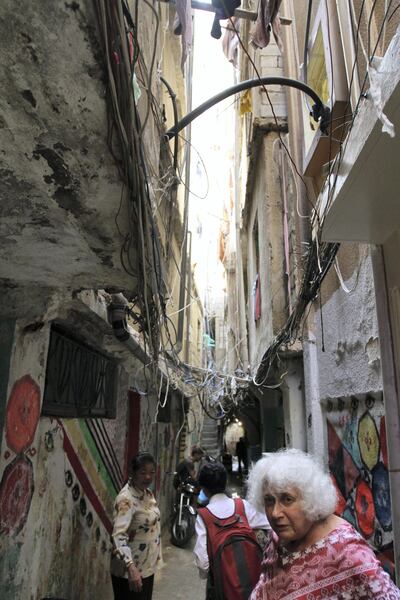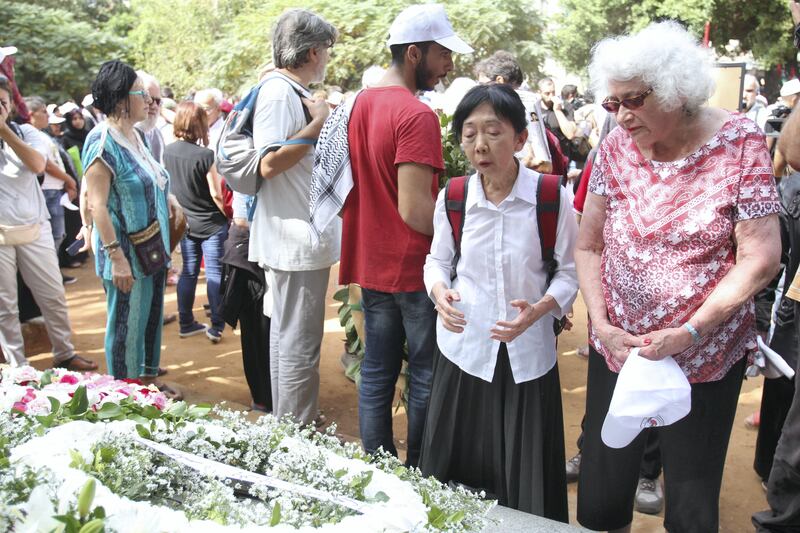Ellen Siegel was working as a volunteer nurse in the Palestinian refugee camp of Shatila in Beirut when Christian militiamen, with the backing of the Israeli military, killed more than 1,000 civilians in the camp and the adjacent neighbourhood of Sabra.
On duty at Shatila's Red Crescent hospital when the massacre began on September 16, 1982, Ms Siegel, an American, said staff there saw flares and went to the roof of the building.
“We could hear the shooting, but we didn’t know what it was."
The Israeli military had invaded Beirut in pursuit of fighters from the Palestine Liberation Organisation, while the militiamen from Lebanon's Phalange party blamed Palestinians for the assassination of Phalangist president Bashir Gemayel.
The flares Ms Siegel saw were fired by the Israeli military to illuminate the area as the Phalangists carried out the systematic killings through the night between September 16 and 18. By the end of the massacre, at least 1,300 Palestinian and Lebanese civilians had been killed, according to Bayan Nuwayhed Al Hout, author of the book Sabra and Shatila: Summer of 1982.
What Ms Siegel was to witness over the course of those three days has stayed with her ever since. For each of the last 17 years, the 75-year-old has travelled to Lebanon with members of an Italian-founded group called "Not to Forget Sabra and Shatila" to mark the massacre's anniversary. The first commemoration, held in 2001, came after the group raised money to help reclaim a mass burial site in Shatila where nearly 1,000 victims of the massacre are buried. Until then the site had been used as a rubbish dump.
This year, Ms Siegel and around 40 other foreign nationals from "Not to Forget Sabra and Shatila" travelled to Lebanon for a week-long trip to mark the massacre's 35th anniversary.
“It’s a way for us to honour them,” Ms Siegel said of the victims as the group visited Shatila on Friday. “We couldn’t do anything to save them.”
_______________
Read more:
[ Shatila's population unknown as Palestinian refugee camp bursts at seams ]
[ Listen: Inside Shatila — Life in Lebanon's most infamous Palestinian refugee camp ]
[ In pictures: Life goes on amid suffering of Beirut's Shatila refugee camp ]
_______________
Although Ms Siegel is not the only foreign witness to the massacre who visits Beirut every year, her motivation for making the trip stands out.
“It’s because I’m Jewish,” said the former Palestinian Red Crescent nurse, who grew up in the US city of Baltimore and now lives in Washington, DC.
"I have an understanding of the history of my people," she added, referring to the role of Jews in causing the Arab exodus from Palestine, "as well as their own history of persecution and suffering".
On Friday, Ms Siegel observed the Jewish tradition of placing stones on graves by putting a pebble on the memorial that marks the mass grave in Shatila where nearly 1,000 bodies are buried.
“I’m not sure why there aren’t more [Jewish] people here with me," she said. "We have a moral responsibility.”
Ms Siegel, who described her upbringing as “conservative”, said her mother was upset by her decision to go to Lebanon.
“My mother thought Israel was very important,” Ms Siegel said. “A place for Jews to go.”
Also visiting Shatila on Friday was Ang Swee, a 68-year-old from London who was working as a doctor at the camp's Red Crescent hospital when the massacre took place.
Ms Swee began making the annual trip to Lebanon in 2013.
“Pretty soon I’ll have to come in a wheelchair,” she joked as she navigated an alleyway in the overcrowded camp that was so narrow it was nearly pitch black, even at noon.
***
Walking down the street between the mass grave and the hospital where she worked, Ms Siegel recalled how residents took shelter in the medical facility before militiamen arrived on September 18 and demanded that its 20 foreign staff members leave.
“They called us communists because we were helping people who killed Christians,” Ms Siegel said. “They took our passports and they marched us out of the camp."
As the hospital staff walked toward the entrance of the camp, the circumstances surrounding the gunfire became clearer. Ms Siegel saw bodies piled in the street, as well as militiamen using bulldozers to cover the mass grave.
She said the militiamen then lined her and the rest of the hospital's foreign staff up against a wall and pointed their guns at them. The staff were saved by an Israeli commander whose forces were guarding the entrances to the camp while the killings took place.
“An Israeli commander came down to tell them that you can’t shoot 20 foreigners,” Ms Siegel said.
While the massacre in Sabra and Shatila was far from the only incident of mass killing that took place during Lebanon’s 15-year civil war, it had one of the highest death tolls and was also unique in the extent to which American officials were aware of what was happening.
_______________
Read more:
[ West turned blind eye to Israel's involvement in Sabra and Shatila 'slaughter' ]
[ Sharon feared genocide charge over Sabra and Shatila ]
[ Memories of 1982 massacre in Palestinian refugee camps kept alive ]
_______________
After Ms Siegel escaped the camp, she said she "went to the American embassy, and I said ‘something is going on in the camp’”.
During the massacre, then Israeli defence minister Ariel Sharon went so far as to warn US diplomats his army would kill any “terrorists” who remained in west Beirut, referring to the PLO fighters who had withdrawn from Shatila the previous month under a deal the United States had helped to arrange. As part of that deal, the US had also promised to safeguard civilians.
From the embassy, Ms Siegel said, she was taken by embassy staff to the port of Jounieh, north of Beirut, and then travelled to Syria by boat.
Within days, the former nurse had returned to Beirut to continue working in the hospital, but left Lebanon for Israel soon after to testify in front of the Kahan Commission investigating the massacre. The commission determined that Mr Sharon, among others, bore responsibility for the killings but no one has ever been formally charged with any crime.

Ms Siegel’s testimony earned her the enmity of many in the global Jewish community, some of who branded her a traitor.
But, to this day, she does not regret her decision to testify.
“I know what I did was right,” she said, adding that she is now trying to work with the Israeli peace movement on the Palestinian refugee issue.
“They’re very good on the occupation. But they’re not interested in refugees."
Like the rest of Lebanon’s 12 Palestinian refugee camps, Shatila is a densely-built, poverty-stricken neighbourhood made up of a maze of concrete buildings, some five stories tall.
During their visit to the camp on Friday, Ms Siegel and Ms Swee visited Beit Atfal Assumoud, a kindergarten that also provides social services for children in the camp. Ms Siegel collects donations to help support Beit Atfal, which is run by a survivor of the 1982 massacre.
"If you want to talk about the occupation of Palestine, you have to talk about the refugees in Lebanon," Ms Siegel added.
"This is the fourth generation in these camps.”





